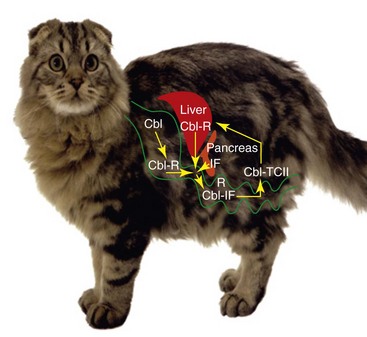Chapter 127 Metabolism of CBL in cats is very different from that in people. CBL homeostasis is a complex, multistep process that involves participation of the stomach, pancreas, intestines, and liver (Figure 127-1). Figure 127-1 The pathway of cobalamin absorption involving the gastrointestinal tract, pancreas, and liver. Cbl, Cobalamin; Cbl-R, cobalamin bound to haptocorrin; Cbl-IF, cobalamin bound to intrinsic factor; Cbl-TCII, cobalamin bound to transcobalamin 2; IF, intrinsic factor. Serum concentrations of CBL are labile and reflect the balance between dietary intake, bacterial use and production, intestinal absorption, and body losses. Factors influencing serum CBL in cats are summarized in Table 127-1. TABLE 127-1 Factors Influencing Serum Concentrations of Cobalamin in Cats *Recognized disease association, pathomechanism unclear.
Cobalamin Deficiency in Cats
Cobalamin Absorption

Increase
Decrease
High dietary content
Dietary deficiency
Parenteral supplementation
Inflammatory bowel disease
*Cholestatic liver disease
Alimentary lymphoma (multicentric lymphoma†)
Exocrine pancreatic insufficiency
Pancreatitis*
Cholangitis*
Hyperthyroidism*
Intestinal bacterial utilization†
Receptor abnormality†
< div class='tao-gold-member'>
Cobalamin Deficiency in Cats
Only gold members can continue reading. Log In or Register to continue

Full access? Get Clinical Tree


